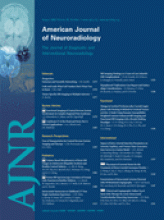The first-time approval of human embryonic stem cell (hESC)-based therapy by the US Food and Drug Administration has highlighted the application of regenerative medicine to human spinal cord injury (SCI). As a result, attention has recently focused on the potential promises and perils of Geron Corporation’s (Menlo Park, Calif) hESC-derived oligodendrocyte progenitor cells (OPCs) in the treatment of human SCI.1 The rationale for the OPC therapy is that remyelination (by oligodendrocytes) of damaged spinal cord axons may improve nerve conduction and, thereby, perhaps neuromotor recovery in patients with SCI. Although the end points for the Geron phase I multicenter SCI trial are primarily safety and secondarily efficacy,2 the addition of noninvasive diffusion tensor imaging (DTI) to track patients treated with OPCs would enhance assessment of the therapy.
DTI, a newer MR imaging technique, provides quantitative information about axonal structure. Of relevance to the recently approved Geron study, on the basis of rodent models of SCI, the DTI measure of transverse diffusivity has been shown to be correlated with demyelination,3 whereas the DTI measure of longitudinal diffusivity has been shown to be correlated with axonal damage.4 In animal models, research is underway to elucidate the sensitivity and specificity of DTI measures for the various pathologies caused by SCI. Given the correlations that exist between conventional MR imaging measures and the degree of myelination,5 longitudinally tracking DTI measures from baseline scan values could provide investigators with additional information about changes in the state of axonal integrity and myelination after OPC therapy.
In addition to the presence of skilled neurosurgical and neuroradiologic teams for the intraspinal injection of OPCs, the presence of human DTI scanning capability should be considered when selecting clinical sites for enrollment of study participants. Indeed, the use of MR imaging to monitor cell transplant therapies in human SCI is not new; Féron et al6 used conventional MR imaging to scan spinal cords 1 year posttransplantation of autologous olfactory ensheathing cells in patients with SCI. However, using DTI in conjunction with conventional MR imaging techniques to image and monitor the progress of this novel therapy would increase the assessment potential of its phase I trial.
References
- American Society of Neuroradiology












